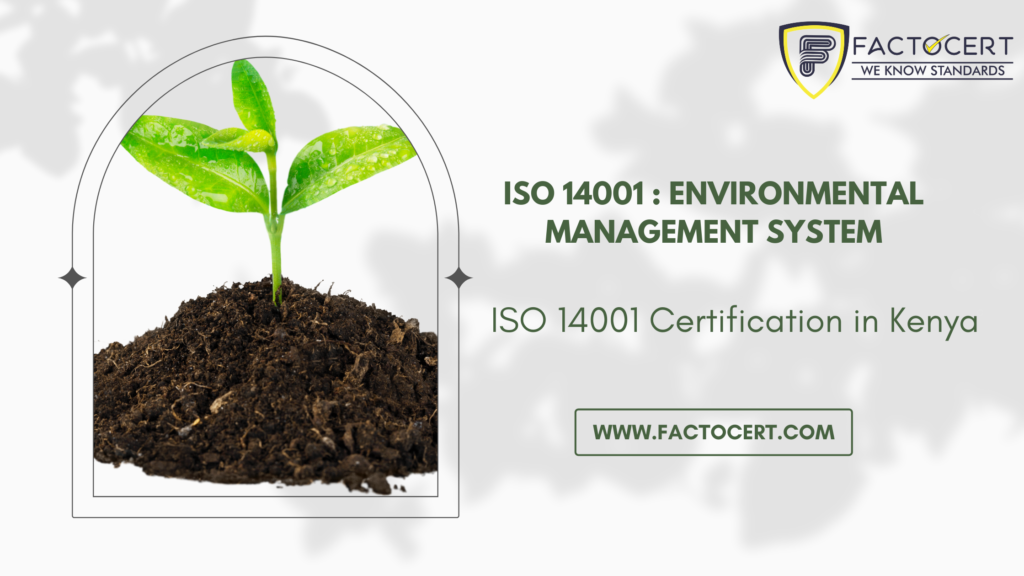Established in 1996 by the International Organization for Standardization, ISO 14001 Certification in Kenya standards are part of a group of norms (ISO 14000) created to encourage and support an approach to environmental management. It’s appropriate for all kinds of organizations (company and NGOs, unions, and so on) looking to improve its process of production operations, management, and production to reduce the environmental impact of its operations. The guidelines in this norm (that were revised in 2015) can be reviewed and verified by an approved agency, which we’ll detail below.
The fundamentals of ISO 14001 Certification in Kenya
The use of ISO 14001 Certification in Kenya is not a legal requirement and, like other standards established by ISO adopting it is voluntary. Although it’s not mandatory, it requires compliance with the environmental regulations in place and the future development of it for those who adhere to the guidelines. The fundamental principle behind ISO norms is to search to improve continuously, over repeated cycles, as per the four-step procedure that is the Deming (PDCA) cycle:
- SS Plan
- SS Do
- SS Study/Check
- SS Act
The advantages of the ISO 14001 Certification in Kenya
ISO 14001 Certification in Kenya standards is above any other management tool. They don’t require certified companies to attain certain environmental targets. However, ISO 14001 demands certificated companies to implement a set of processes that have to be followed to reduce their environmental impact. An ISO 14001 Certification in Kenya certified organization is not necessarily an eco-friendly one. What it does mean is that it has a procedure that allows it to work on environmental concerns.
- Develop corporate image and credibility
- Assess, measure, and monitor the impact of the operations on the environment, both now and shortly.
- Assist in ensuring that you are aware of the law and ensure awareness and conformity
- Enhance your supply chain’s environmental efficiency.
- Guard the company’s shareholders, assets as well as directors
- Potentially lower the cost of insurance for public liability for your business
- Increase your reach to business partners as well as potential customers
What does ISO 14001 Certification in Kenya look like?
Its ISO 14001 structure is split into ten parts. The three first sections are introductions sections, while the remaining seven cover the requirements of the system for environmental monitoring. The seven major sections of the document are about:
1. Context of the company – The following section discusses the requirements to understand your company to set up an EMS. This includes requirements for identifying external and internal issues, identifying the parties involved and their requirements as well as defining the scope of the EMS, and defining the steps required for the EMS.
2. Leadership – The requirements for leadership include the requirement for the top management to play involved in the execution of EMS. Top management should demonstrate their commitment toward and support for the EMS by ensuring that they are committed to environmental protection as well as creating and communicating the policy on environmental issues and the assignment of roles and responsibilities across the company.
3. Planning – Top management should also plan for the continual purpose of the EMS. The risks and opportunities associated with the EMS within the organization have to be assessed, as well as environmental goals to be improved must be identified and strategies developed to achieve these goals. In addition, the company must evaluate how its organizational processes impact the environment, as well as all legal obligations that must be met by the company.
4. Help – The support section is concerned with the managing of all resources in the EMS as well as the requirements for the ability, awareness, competence, and controlling the documentation (the documents and documents required to support your processes).
5. Operations – The requirements for operations cover the entire range of environmental controls required by the process of organization, as well as the need to determine the possibility of emergencies and plan your response to ensure that you are ready to act in the event of an emergency.
6. Performance evaluation – This section contains the essentials necessary to ensure that you know if your EMS is running smoothly. This includes monitoring and evaluating your processes, evaluating environmental compliance internal audits, as well as continuous management reviews and reviews of your EMS.
7. Improvement – The last section contains the essentials to improve your EMS improve over time. This is a requirement to determine the cause of non-conformity in your process and then take corrective action for processes.
This section is built on a Plan-Do-Check-Act cycle that uses these elements to bring about change within the process of the company to drive and maintain improvement within the process.
Why should you choose Factocert Consultant Company to get ISO 14001 certification in Kenya?
Factocert is one of the top ISO 14001 Consultant Companies in Kenya We offer the best ISO Solutions, CE mark, HALAL, HACCP Certification with auditing and training, in addition to the documentation at a cost-effective. We also offer services for Kenya cities like Nairobi, Kisumu, Eldoret, Malindi, Garissa, along with other cities.
If you have any ISO 14001 Certification in Kenya or other Certification consultant services please visit our site: www.factocert.com or contact@factocert.com





